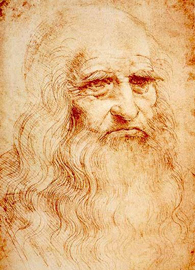Leonardo da Vinci will forever be known for “The Last Supper” and “Mona Lisa.” But there was more to the man than his art. Da Vinci was also known for his scientific research and observations. His name has been popularized through books and movies, and his works continue to be studied even today.
Leonardo Da Vinci’s Early Days
Leonardo da Vinci was born on April 15, 1452, the illegitimate son of a notary named Ser Piero and a peasant girl called Caterina. The young boy grew up around art and scholarly books, thanks to his father, who eventually apprenticed the teenager to an artist, Andrea del Verrochio, a renowned painter in Florence. There, the 15-year-old’s immense talent was first observed.
According to one story, the young Leonardo painted an angel in Verrochio’s work, “Baptism of Christ,” and it was so much better than his master’s that Verrochio swore then and there never to paint again.
In 1482, Leonardo went to serve under the Duke of Milan, and remained in the city for 17 years. He quickly demonstrated his versatility: The Duke had him paint and sculpt, but also design weapons, machinery and building. The young artist also studied science, and drew detailed figures of human anatomy.
Giorgio Vasari, a 16th century historian, wrote of da Vinci’s varied skill set, “Truly marvellous and celestial was Leonardo…and in learning and in the rudiments of letters he would have made great proficience, if he had not been so variable and unstable, for he set himself to learn many things, and then, after having begun them, abandoned them.”
Sources in this Story
- Museum of Science: Renaissance Man
- Fordham University: Medieval Sourcebook: Giorgio Vasari: Life of Leonardo da Vinci 1550
- The Metropolitan Museum of Art: Leonardo da Vinci (1452–1519)
- Universal Leonardo: Second Florentine period 1500-1506/08
- findingDulcinea: On this Day: The “Mona Lisa” is Stolen
- The Christian Science Monitor: ‘Da Vinci Code’ sets a record, inspires a genre
Da Vinci’s Notable Accomplishments
Leonardo’s famous lack of “stick-to-it-ness” meant he only completed six works during his 17 years in Milan, including “The Virgin on the Rocks” as well as “The Last Supper.” In the painting, Leonardo captured the moment just after Christ tells the apostles that one of them will betray him. According to art critics, their very different reactions to the news express what the painter called the “motions of the mind.” The painting, which underwent a major restoration from 1979 to 1999, hangs in the refectory of Santa Maria delle Grazie in Milan.
But without a doubt, Leonardo’s most famous work is the “Mona Lisa”—the painting of the woman with the mysterious smile—and it may be the most famous work of art in the world.
To this day, the painting remains a popular subject of speculation. It is believed that Leonardo began the work in the early 1500s in Florence. No one is sure who Leonardo’s subject was in the painting, though she is thought to be a Florentine woman. Some argue that the sitter is Lisa Gherardini, the wife of a Florentine silk merchant. Others contend that “Mona Lisa” is a combination of many women, not just one, or that it’s a man in a woman’s clothes. Still others claim that she is a self-portrait.
The Man and His Work
- “Leonardo’s Notebooks” by Leonardo da Vinci
- “Leonardo Da Vinci: 1452-1519: The Complete Paintings and Drawings” by Frank Zollner, Johannes Nathan
- Leonardo’s Machines: Da Vinci’s Inventions Revealed” by Domenico Laurenza, Mario Taddei
- Da Vinci and the Code He Lived By” by the History Channel
The Rest of the Story
Leonardo da Vinci died at the age of 67 on May 2, 1519, near Amboise in France. His name has continued to make headlines throughout the centuries.
In August 1911, authorities in France panicked and closed the country’s borders after museum employee Vincenzo Perugia stole the “Mona Lisa” from the Louvre, believing that it rightfully belonged to his native Italy. The painting was recovered two years later when Perugia offered to return the painting for 500,000 lire. He was later arrested.
Perhaps one of the most widespread revivals of da Vinci’s name was through Dan Brown’s best-selling novel, “The Da Vinci Code.” The book, a mystery/thriller, features Robert Langdon, a Harvard professor of symbology who is searching for clues about Christ’s life. Central to the plot are Leonardo’s paintings—especially “The Last Supper”—as the characters uncover the true story of Mary Magdalene and Jesus. The book was made into a movie starring Tom Hanks in 2006.
Da Vinci’s spirit lives on through his work. As Vasari wrote of the painter, “In him was great bodily strength, joined to dexterity, with a spirit and courage ever royal and magnanimous … not only in his lifetime was he held in esteem, but his reputation became even greater among posterity after his death.”
This article was originally written by Cara McDonough; it was updated March 9, 2017.











